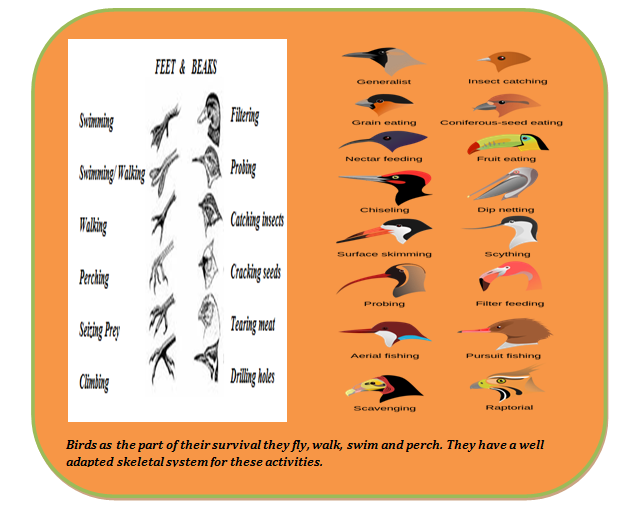Mantle - tissue cavity surrounding respiratory cavity 4. In animal locomotion kinematics is used to describe the motion of the body and limbs of an animal.

Locomotion And Movement Of Animals And Their Body Structure Byju S
We went over three types of locomotion.

. A spider monkeys tail is prehensile and used in locomotion. Recent empirical work shows that the scheme of four modes of snake locomotion is overly conservative. Unguligrade mammals walk and.
They move the same two legs on each side in alternate steps 1 3 2 4 rather than the 1 4 2 3 pattern of most mammals and nearly all ungulates such as horses goats sheep and bison. Kinematics is the study of how objects move whether they are mechanical or living. Cursorial - Running c.
A jerboas tail is used as a counterweight and balance. When moving plantigrade animals keep the heel bone on the ground digitigrade animals move by only the digits touching the ground. Slither glide hop wiggle run jump the list of ways animals move is countless.
Locomotion involves change of place. In addition to powered flight we see. Explore the diverse ways in which animals move and explore examples of locomotion including flying swimming crawling and walking on four and two feet.
Angular movements are produced when the angle between the bones of a joint changes. Primate locomotion can be classified on behavioral grounds into four major types. The wide range of movement allowed by synovial joints produces different types of movements.
The primitive mammalian stock walked plantigradethat is with the digits bones of the midfoot and parts of the ankle and wrist in contact with the ground. It supports the animal and helps to maintain body shape. These light-weight animals have adapted to their.
- mammals evolve to live in their niches through changes in bodies and limbs name four types of terrestrial locomotion ambulatory cusorial graviportal and saltatorial What does ambulatory mean and what GROUPS of animals use this. Mammals are also noted for their ability to move rapidly. Locomotion by Mucilage Propulsion.
The locomotion of terrestrial mammals can be classified into 3 types from part for contact the ground. A red kangaroo uses its tail as a support while upright. Animal locomotion in ethology is any of a variety of methods that animals use to move from one place to another.
Can you describe why it is so fast. Generally the limbs of mammals are very mobile and capable of rotation. Illustration by Gillian Harris Mammal tail.
MAGNE DE LA CROIX For many years I have studied the locomotion of vertebrates with a view to an understanding of the evolutionary steps that have led to the different sorts of progressive movements characteristic of various mammal types. Animals of all size and shape move in search of shelter food mate and to escape from predators using their different body parts like fins legs wings and so on. Most can fly some can run very well some swim and some do combinations of these.
01182022 Animals Move If you. It is slow creeping type of locomotion which is performed with the help of protoplasmic outgrowths called pseudopodia. Mammals are noted for their diversity of modes of locomotion or ways of moving about.
Vertical clinging and leaping quadrupedalism brachiation and bipedalism. Flying birds wings are shaped to provide lift allowing them to fly. MAGNE DE LA CROIX-LOCOMOTION IN MAMMALS THE EVOLUTION OF LOCOMOTION IN MAMMALS BY P.
The goal is ultimately to understand how the movement of individual limbs relates to the overall movement of an animal within its environment. Some animals such as bears giraffes and camels actually have a different gait and stride than most. The osprey pictured above is well-adapted to plunge into water mid-flight to catch fish.
A northern flying squirrel uses its tail as a rudder. Surface-oriented larger mammals depending on speed for catching prey or survival show cursorial locomotion. Visceral mass - where most organs are located.
Moving the forearm upward at the elbow is an example of flexion. Saltatorial - Hopping b. Some sort of skeleton within endoskeleton or outside exoskeleton the body is present in most animals.
Walking and plantigrade Describe a plantigrade - walks on palms and soles - 5 digits on front and back. Larger mammals including carnivores horses zebras deer pronghorn antelopes cattle bison giraffe show this type of locomotion. Mammalogy Lecture 10 - Locomotion III.
A narwhals tail propels it through the water. They have long paired legs also they have large muscles in the back of there body. Flexion or bending occurs when the angle between the bones decreases.
Hard Shell - protection 3. Scansorial - Climbing d. For several decades different types of snake locomotion have been categorized as one of four major modes.
Most of the aquatic animals have a neutral. Locomotion refers to the movement or the ability to move from place to place. A mule deers tail can communicate an alarm.
It requires a means for support development of a thrust against surrounding medium and stability. Muscular Foot - usually locomotion 2. Cursorial Running type of locomotion.
Bird locomotion is quite varied. The definition of hopping is to move by leaping with all feet off the ground. Rectilinear lateral undulation sidewinding and concertina.
Flight swimming and land locomotion. Types of Locomotion I. Look closely at the cheetahs body.
Hares kangaroos and Gerbils are some of the hopping mammals. The limbs of ambulatory mammals are typically. Specialization in habitat preference has been accompanied by locomotor adaptationsTerrestrial mammals have a number of modes of progression.
Some modes of locomotion are initially self-propelled eg running swimming jumping flying hopping soaring and gliding. Well it does. In general we can recognize several types of locomotory specializations in mammals.

Types Of Locomotion In Animals Video Lesson Transcript Study Com

Terrestrial Locomotion Behaviour Britannica

Locomotion In Mammals Advanced Read Biology Ck 12 Foundation
0 Comments